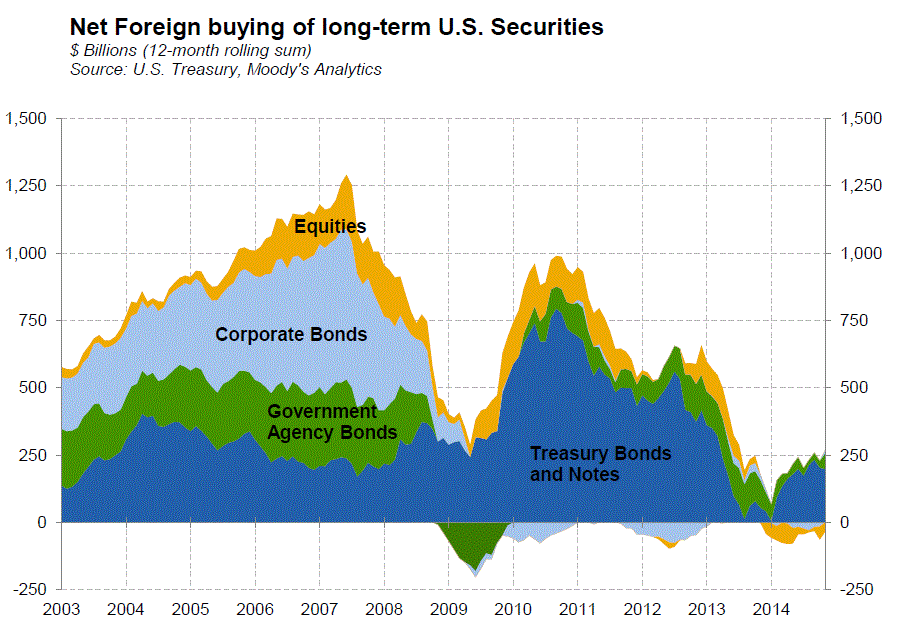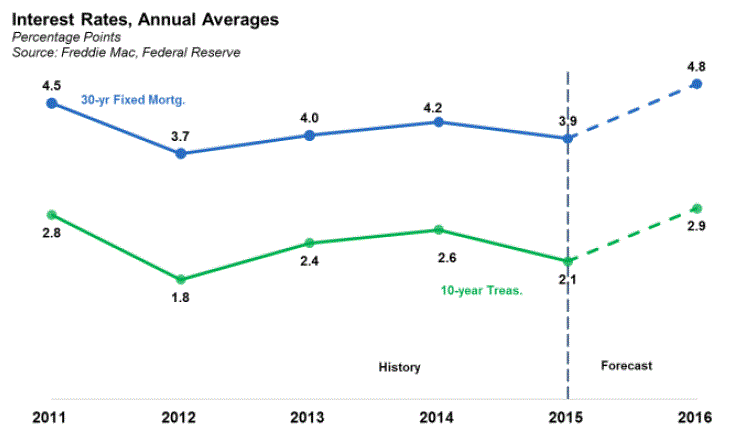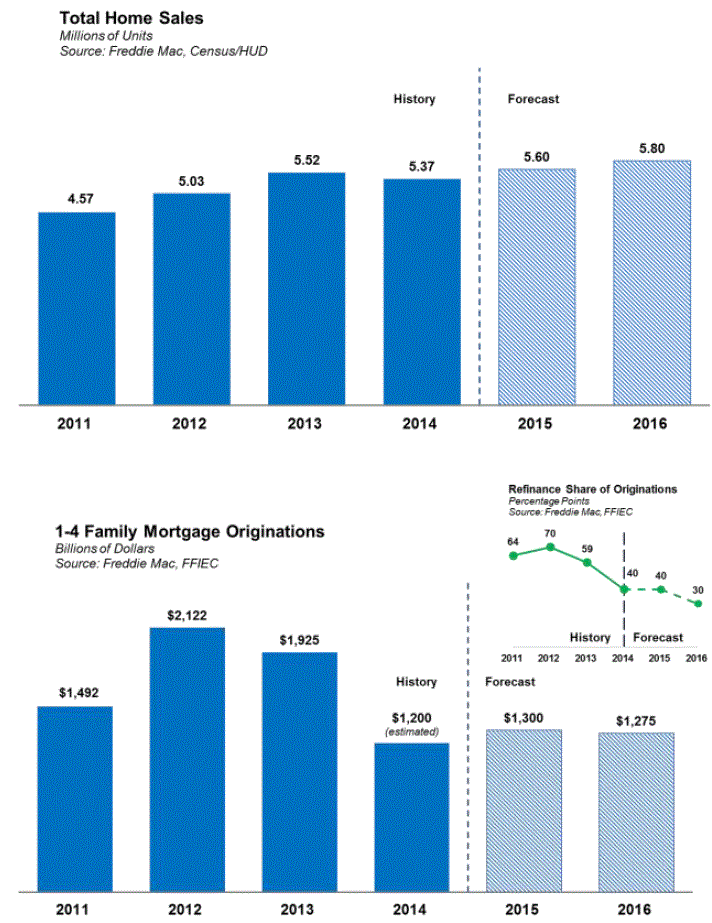Blog

Freddie's Economic Revisions Optimistic for Housing
Freddie Mac’s economists have revised many of their earlierrnestimates for the 2015 U.S. economy. Inrnterms of overall economic growth the revisions are not positive as they see arnslowing of “the torrid pace in the third quarter of 2014,” but their newrnprojections are good news for housing, with lower rates and a higher level ofrnmortgage originations. </p
Leonard Kiefer, Freddie Mac’s Deputy Chief Economist, saidrnin February’s edition of the U.S.rnEconomic & Housing Outlook, that there is considerable tension inrninterest rates. While it is expectedrnthat the Federal Reserve will begin raising short-term rates this year, thernprevailing theory is between mid-year and the third quarter, long term ratesrnhave fallen from their peaks in 2014. rnTen-year Treasuries have declined by about ½ percentage point sincernOctober, twice reaching as low as 1.68 percent, the lowest rate since 2012.</p
Since the most recent low on February 2 strong employment figuresrnhave caused rates to bounce back but they remain below levels at the beginningrnof the year, Even if the Fed raisesrnshort-term rates sooner than anticipated, it is unlikely, Kiefer says, to leadrnto a dramatic rise in their long-term counterparts. </p
Even as there has been a recent increase in short-term ratesrnin anticipation of Fed action, long term rates continue to decline, resultingrnin a flattening of the yield curve. rnAnalysts often interpret this phenomenon as indicative of a weakeningrneconomy and a possible warning of an approaching recession.</p
Kiefer said there are two theories for the recent loweringrnof long-term rates. One is that thesernrates are based upon expectations for short-term rates and factors in a termrnpremium to compensate for risk. Underrnthis theory the recent decline is the result of lowered expectations for shortrnterm rates and, if investors accept that the economy is weakening they willrnaccept lower premiums to compensate for risk.</p
The competing theory is that short-term and long-termrnsecurities are not close substitutes and thus movements in the former havernlimited effects on the path of the latter which are instead driven primarily byrnsupply and demand dynamics within the securities markets. “Thusrnit is supply (issuance of debt less retired securities and central bankrnpurchases) and demand (domestic saving and foreign capital flows) for long-termrnbonds that drive long-term interest rate movements. The sharp decline in thernbudget deficit since 2009 has reduced net Treasury issuance, despite arnsystematic effort by Treasury to extend the average weighted maturity of itsrndebt portfolio. The result is a reduced incremental supply of long-datedrnsecurities.”</p
At the same time,rnevents in the global arena such as reduced interest rates in Europe and Japanrnand growing concerns over global growth have driven a flight to safety and intornpurchases of long-term U.S. securities. rnThe latest data from November, portrayed in the chart below, shows thernrecent surge in net foreign buying of these securities, especially Treasuryrnbonds and notes. Recent trends support earlierrnresearch showing that net foreign purchases of long-term securities have arnlarge impact on long-term rates.</p
 </p
</p
Freddie Mac’s economistsrnadhere to the theory that the recent declines in long-term rates are a functionrnof reduced availability of long-term Treasuries and increased foreign demandrnrather than fears of a weakening U.S. economy. rnFurthermore, they expect recent trends in foreign buying activity torncontinue which means continued downward pressure on long-term interest rates. Even if the Fed does begin to raisernshort-term rates later this year, they don’t expect to see long term ratesrnincrease much. They do expect that therernwill be considerable volatility in rates in the weeks leading up to and afterrnthe Fed moves.</p
That said, FreddiernMac is revising its projections for many of the major economic indicators fromrnthose it made last month. Overall economicrngrowth for the first quarter of 2015 is now put at 2.5 percent rather than 3.0rnpercent and 2015’s annual growth will be 2.9 percent, 0.1 percent below earlierrnpredictions.</p
But for the 30-yearrnfixed rate mortgage, change is good. Therncompany estimates that the average rate for 2015 will be 3.9 percent ratherrnthan the 4.2 percent it projected last month. rnAverage rates in 2016 will rise to 4.8 percent.</p
 </p
</p
Further, lower ratesrnalong with an improving jobs picture continue to provide a brighter outlook forrnhousing activity this year than last. rnFreddie Mac holds to its prior forecasts of 5.6 million in home salesrnthis year and 1.18 million residential construction starts. They have raised their estimate of home pricerngrowth from January’s 3.5 percent to 3.9 percent in 2015. The projections for higher home prices andrnlower rates have led them to push estimates for 2015 one-to-four familyrnmortgage originations up from $1.2 trillion last month to $1.3 trillion, easingrnback to $1.275 trillion in 2016. rnRefinancing will also take a larger share of overall mortgage business,rnrising is the revisions from 35 to 40 percent. </p

All Content Copyright © 2003 – 2009 Brown House Media, Inc. All Rights Reserved.nReproduction in any form without permission of MortgageNewsDaily.com is prohibited.
Latest Articles
By John Gittelsohn August 24, 2020, 4:00 AM PDT Some of the largest real estate investors are walking away from Read More...
Late-Stage Delinquencies are SurgingAug 21 2020, 11:59AM Like the report from Black Knight earlier today, the second quarter National Delinquency Survey from the Read More...
Published by the Federal Reserve Bank of San FranciscoIt was recently published by the Federal Reserve Bank of San Francisco, which is about as official as you can Read More...

Comments
Leave a Comment